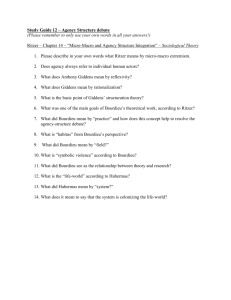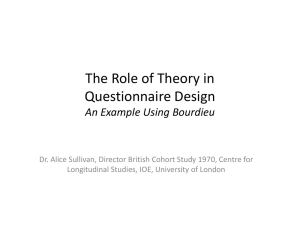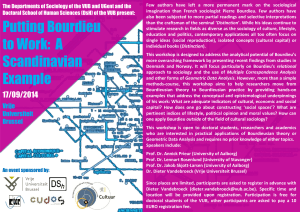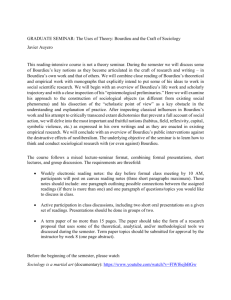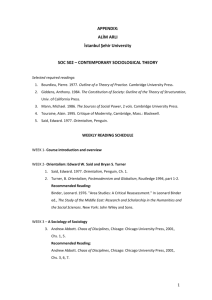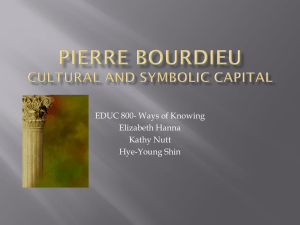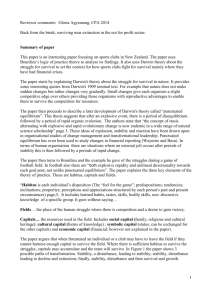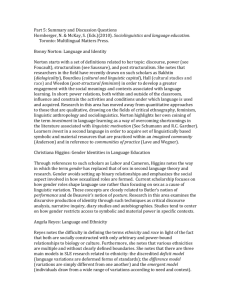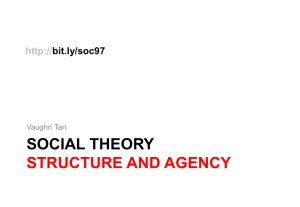Practices and actions: A Wittgensteinian critique of Bourdieu and
advertisement
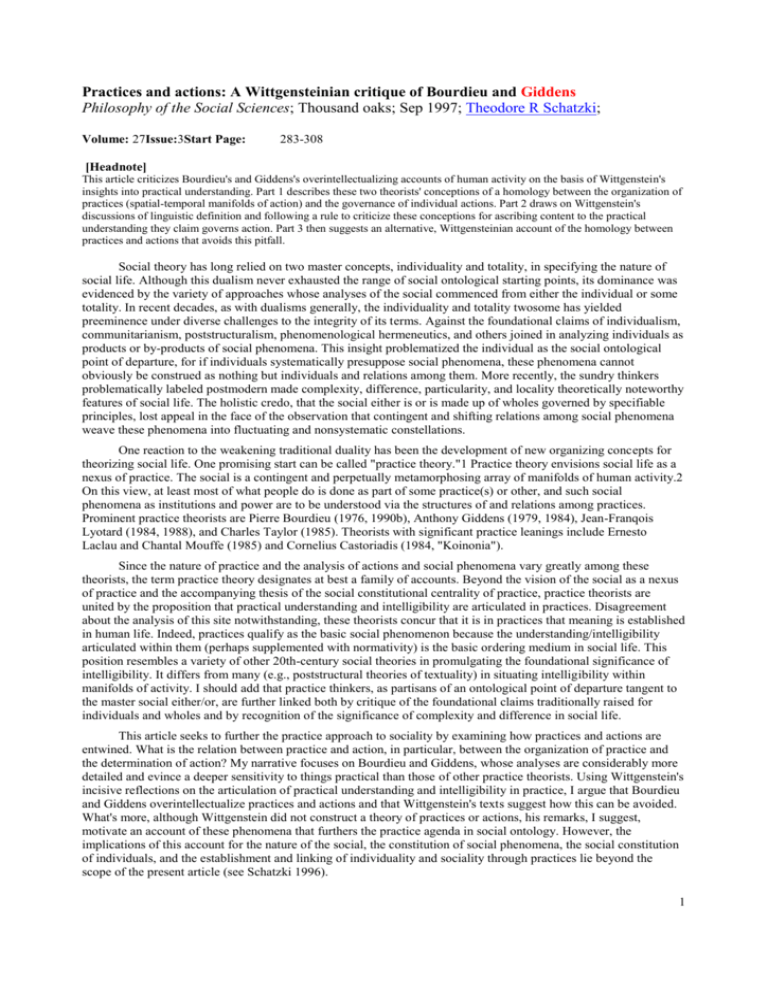
Practices and actions: A Wittgensteinian critique of Bourdieu and Giddens Philosophy of the Social Sciences; Thousand oaks; Sep 1997; Theodore R Schatzki; Volume: 27Issue:3Start Page: 283-308 [Headnote] This article criticizes Bourdieu's and Giddens's overintellectualizing accounts of human activity on the basis of Wittgenstein's insights into practical understanding. Part 1 describes these two theorists' conceptions of a homology between the organization of practices (spatial-temporal manifolds of action) and the governance of individual actions. Part 2 draws on Wittgenstein's discussions of linguistic definition and following a rule to criticize these conceptions for ascribing content to the practical understanding they claim governs action. Part 3 then suggests an alternative, Wittgensteinian account of the homology between practices and actions that avoids this pitfall. Social theory has long relied on two master concepts, individuality and totality, in specifying the nature of social life. Although this dualism never exhausted the range of social ontological starting points, its dominance was evidenced by the variety of approaches whose analyses of the social commenced from either the individual or some totality. In recent decades, as with dualisms generally, the individuality and totality twosome has yielded preeminence under diverse challenges to the integrity of its terms. Against the foundational claims of individualism, communitarianism, poststructuralism, phenomenological hermeneutics, and others joined in analyzing individuals as products or by-products of social phenomena. This insight problematized the individual as the social ontological point of departure, for if individuals systematically presuppose social phenomena, these phenomena cannot obviously be construed as nothing but individuals and relations among them. More recently, the sundry thinkers problematically labeled postmodern made complexity, difference, particularity, and locality theoretically noteworthy features of social life. The holistic credo, that the social either is or is made up of wholes governed by specifiable principles, lost appeal in the face of the observation that contingent and shifting relations among social phenomena weave these phenomena into fluctuating and nonsystematic constellations. One reaction to the weakening traditional duality has been the development of new organizing concepts for theorizing social life. One promising start can be called "practice theory."1 Practice theory envisions social life as a nexus of practice. The social is a contingent and perpetually metamorphosing array of manifolds of human activity.2 On this view, at least most of what people do is done as part of some practice(s) or other, and such social phenomena as institutions and power are to be understood via the structures of and relations among practices. Prominent practice theorists are Pierre Bourdieu (1976, 1990b), Anthony Giddens (1979, 1984), Jean-Franqois Lyotard (1984, 1988), and Charles Taylor (1985). Theorists with significant practice leanings include Ernesto Laclau and Chantal Mouffe (1985) and Cornelius Castoriadis (1984, "Koinonia"). Since the nature of practice and the analysis of actions and social phenomena vary greatly among these theorists, the term practice theory designates at best a family of accounts. Beyond the vision of the social as a nexus of practice and the accompanying thesis of the social constitutional centrality of practice, practice theorists are united by the proposition that practical understanding and intelligibility are articulated in practices. Disagreement about the analysis of this site notwithstanding, these theorists concur that it is in practices that meaning is established in human life. Indeed, practices qualify as the basic social phenomenon because the understanding/intelligibility articulated within them (perhaps supplemented with normativity) is the basic ordering medium in social life. This position resembles a variety of other 20th-century social theories in promulgating the foundational significance of intelligibility. It differs from many (e.g., poststructural theories of textuality) in situating intelligibility within manifolds of activity. I should add that practice thinkers, as partisans of an ontological point of departure tangent to the master social either/or, are further linked both by critique of the foundational claims traditionally raised for individuals and wholes and by recognition of the significance of complexity and difference in social life. This article seeks to further the practice approach to sociality by examining how practices and actions are entwined. What is the relation between practice and action, in particular, between the organization of practice and the determination of action? My narrative focuses on Bourdieu and Giddens, whose analyses are considerably more detailed and evince a deeper sensitivity to things practical than those of other practice theorists. Using Wittgenstein's incisive reflections on the articulation of practical understanding and intelligibility in practice, I argue that Bourdieu and Giddens overintellectualize practices and actions and that Wittgenstein's texts suggest how this can be avoided. What's more, although Wittgenstein did not construct a theory of practices or actions, his remarks, I suggest, motivate an account of these phenomena that furthers the practice agenda in social ontology. However, the implications of this account for the nature of the social, the constitution of social phenomena, the social constitution of individuals, and the establishment and linking of individuality and sociality through practices lie beyond the scope of the present article (see Schatzki 1996). 1 I. BOURDIEU AND GIDDENS ON PRACTICE AND ACTION What is a Practice? The term practice has fascinated thinkers and rallied polemics during the past 150 years of social thought. To a large extent, this reflects its status along with theory as two allegedly contrasting vocations. Although the notion of practice as involvement in political and/or economic affairs is hardly absent from Bourdieu's and Giddens's texts, two other connotations of the term define the practices they analyze: (1) practices as spatially-temporally extended manifolds of actions and (2) practice as the carrying out of actions. Practices are interwoven activities in a given social domain such as agriculture, cooking, the economy, and politics. Each is a spatialtemporal manifold3 of actions whose constituents form a nexus-as opposed to an aggregation-in existing only in conjunction with other members of the manifold. Bourdieu and Giddens differ about what this involves, but the general point is that practices are ontologically more fundamental than actions;4 the identity (being) of at least most, if not all, actions is tied into practices. Individualist theories, by contrast, accord priority to action, tying the identity of particular actions to properties of the individuals who perform them (e.g., goals, intentions, and other mental states), and treat practices as contingent agglomerations of already constituted actions. Whereas on practice accounts the actions that comprise a practice are governed essentially by something in common, those comprising social phenomena on individualist analyses are governed by the conjunction of the relevant, only circumstantially identical or interwoven properties of individuals. The second notion of practice defining the object of Bourdieu's and Giddens's accounts is that of performing an action or carrying out a practice of the first sort. This notion denotes the doing-the activity or energizationthrough which action takes place. Since it names the activity at the core of human life, it is central to any analysis of human existence. It is also closely related to the first sort of practice. The actions that comprise a practice are only in being performed. Hence, practice in the sense of doing actualizes and sustains practices in the sense of spatialtemporal nexuses of doings. The practice theories of Bourdieu and Giddens are accounts of both sorts of practice at once.5 They specify the organization of action nexuses, that which unifies actions as a manifold, while also detailing that which governs the performance of individual actions. This formulation might suggest that practice theories contain two disparate components, one concerned with the organization of practices, another with the determination of actions. These formulaically distinct components are in fact two sides of a single account, for Bourdieu and Giddens treat the organization of practices as identical and/or homologous with the determination of individual actions. This coincidence reflects the facts that nexuses of action exist only insofar as their constituent actions are performed and that the being of an action is tied to the manifold of which it is part. Although Bourdieu and Giddens disagree about the extent of identity or homologous structuring, delineations of the common structure of practices and actions are central to their accounts. Each theory's particular and differentlooking accounts of the organization of practice and the determination of action results from the application and differing roles of the common structure in different domains. I add, parenthetically, that the coincidence between a practice and its constituent actions does not imply that all properties of practices are inscribed in the determination of action. The characteristics of practice nexuses, for instance, are generally not transcribed there. Bourdieu: Habitus and Practices My discussions of Bourdieu and Giddens focus on their abstract, theoretical accounts of practice and action (i.e., Bourdieu 1976,1990b; Giddens 1979,1984) and consider neither the remaining wealth of their theoretical corpora nor the relation of these accounts to their empirical or more empirical investigations (for discussion of the relation of empirics and theory in Bourdieu, see Robbins 1991, chaps. 8 and 9). My presentation also highlights certain aspects of their accounts (above all, practical understanding) while de-emphasizing other important components (e.g., power). I do this because the bearing of Wittgenstein's texts on relations between practice and action centers on the nature of practical understanding and because Bourdieu's and Giddens's analyses of this understanding underlie many further components of their wider accounts. Their analyses here are also less attended to in the secondary literature. Bourdieu's governing intuition is that practices are self-perpetuating. Practices, in his scheme, are the interwoven activities (or games) carried out in a specific domain of practice, or field. Activities in a given field are produced by dispositions, which are acquired under the objective conditions characterizing this field and, structured homologously with these objective conditions, produce actions that perpetuate the practices and conditions found there. Bourdieu calls these dispositions habitus. The common structure of fields and habitus is most clearly revealed in Bourdieu's analysis of the latter. The first thing to note is that habitus is responsible not just for action, but for thought, understanding, motivation, and perception as well. These dispositions maintain, moreover, a twofold relation to action: they generate actions, that is, 2 causally produce them, while also selecting which actions to generate. Of greatest significance in the present context is Bourdieu's analysis of habitus as the selection principle of practice. The actions that habitus selects are sensible and reasonable (e.g., Bourdieu 1990b, 14, 50). Sensible and reasonable means first, that an action is appropriate given the situation and the functions of action in that situation and second, that it makes sense to the actor, that is, to someone whose dispositions have been formed within certain practices (e.g., Bourdieu 1976, 79;1990b, 60). It follows that the actions habitus selects will also seem sensible and reasonable to other actors who have grown up and are accustomed to the same practices and conditions. Correlatively, the actions of these other people will make sense to the actor. The homology of the habitus of actors who grow up and live amid the same practice-established objective conditions further ensures that the actions they individually perform add up to regular, unified, and systematic (Bourdieu 1990b, 59) practices. Most important, the selection of action obeys what Bourdieu calls "practical logic." Practical logic is a representation of the principles habitus observes in selecting actions. In any context, habitus selects actions by producing (a) a definition of the situation of action (which assigns meanings to objects, persons, and events; delineates a probable upcoming future; and prescribes things to do/say and not to do/say) and (b) a definition of the functions of action in that situation (Bourdieu 1976,142;1990b, 267). Following the Saussurian intuition that meaning devolves from differences, Bourdieu contends that these definitions are composed via systems of difference, which in Bourdieu are oppositions. Examples are day versus night, wet versus dry, soft versus hard, smooth versus rough, and hot versus cold. The oppositions that habitus wields form families, each based on a fundamental opposition, sets of which vary among societies. Practical logic, then, is a description of the principles that govern the definition of the situations and functions of action through the construction and application of families of oppositions. Although Bourdieu never spells this out precisely, it is reasonable to suppose that objects, persons, and events acquire meaning by being subsumed into the families of oppositions; that probable futures and prescribed/proscribed actions are delineated on the basis of these meanings; and that the functions of actions follow from these assignments and delineations. In this way, the selection of action is structured by oppositions. I note that the action that best fits the definition of the functions of action in a given situation is often the action that maximizes the actor's capital. Bourdieu argues that practice generally follows the logic of the maximization of capital, not only material (economic) capital, but social and symbolic as well (Bourdieu 1976,183;1990b, 16). With regard to the governing of action, this presumably means that habitus observes this logic in selecting which of those actions that could fulfill the functions of action is the one performed. Three features of this account should be highlighted. The first is the strongly teleological character just referred to. Not only does privileging the maximization of capital lash action to one overall sort of end, but analyzing actions as selected through definitions of their situation and functions obscures the practical significance of emotions and moods. The second notable feature is that the definitions that select actions are multidimensional propositions. The third feature is the thesis that habitus alone determines activity. This follows from the claim that habitus generates other putative activity-determining phenomena such as thoughts and motivations (including ends, projects, and plans) (Bourdieu 1976, 21, 72; cf. 1990b, 61). The system of oppositions that structures the selection of action also structures the organization of practices. Bourdieu's account of this organization is problematic, however, for he insists in his theoretical work (see note 10 on other texts) that it is not with practices but with the objective conditions established by them that dispositions are homologously structured. These objective conditions have two basic dimensions: statistical regularities and networks of groups. Examples of the relevant statistical regularities are price curves, chances of access to higher education, and frequency of holidays. Groups are objective entities (a) defined by the possession of certain cultural, symbolic, and material capitals (thus by age, education, occupation, possessions, rank, family, and the like) and (b) marked by the pursuit of certain actions and lifestyles. One extremely important type of group is economic class, which is an ensemble of individuals occupying similar positions within the distribution of economic capital. Bourdieu's idea is that within a given field (and thus more generally in a world composed of such and such games in this and that field), such parameters as prices, chances of access, and frequencies of holidays are statistically regular and the particular prices, chances, and frequencies people face reflect the groups to which they belong (thus the capitals they possess) as well as relations among these groups (for discussion, see Bourdieu 1985). Problematic here are not the objective conditions per se, but how they can even in principle be homologous to habitus. Suppose that certain statistical regularities having to do with prices, frequencies, and the like track economic class-specifically, the distribution of economic, in possible conjunction with other, capitals. The structure of these regularities would then consist of conjunctions of the values assumed by different socioeconomic variables together with whatever mathematically or linguistically describable relations characterize either the regularities or 3 the sets of conjuncts. These conjunctions and relations are clearly not homologous with the oppositionbased structure of habitus's definitions of the situation. Bourdieu is right, of course, that people belonging to a given economic class tend to face similar frequencies of holidays and the like. He may also be right that such people tend to act in similar ways, at least insofar as their actions are keyed to those conditions. But these facts in no way suggest that their dispositions and the collocation of statistical regularities are structured alike. It is logically wiser to postulate that habitus is structured homologously with the action manifolds it produces. Indeed, pace his general formulations, in Bourdieu's analyses of particular fields (e.g., cooking, farming, and gift giving) in the texts under consideration, what in these fields the families of oppositions that structure habitus are analyzed as organizing are practices, not the objective conditions practices establish (cf. Bourdieu 1976, 130-157; 1990b, book II). The Kabylian cooking cycle, for instance, exhibits a temporal organization of what is cooked when that is structured by such oppositions as boiled/roasted, sweet/salt, bland/spiced, and wet/dry Similarly, the layout of the built environment, the house and its spaces (see Bourdieu 1990b, 271-83) as well as the wider arrangements of towns and agricultural fields, exhibits an opposition-based organization. It turns out that what the system of oppositions that structures the selection of actions simultaneously structures is the spatial-temporal organization of the nexuses of which these actions are parts. Giddens: Rules, Resources, and Practices Giddens's guiding intuition, much like Bourdieu's, concerns the perpetuation, in his words, the "space-time extension," of practices. As he sees it, practices extend themselves by continuously renewing the conditions that determine them. For both theorists, therefore, structures are the "medium and result" (Giddens 1979, 69; 1984, 25) of practices (for a third version of this figure, see Bhaskar 1979). I should add that for Giddens, practices form constellations called systems, whose structures encompass relations among the structures of practices. A practice, furthermore, is a nexus of actions. This means that the renewal of structure whereby practices perpetuate themselves must come about through the actions that compose them. Giddens proposes, as a result, that actors draw on structures, thereby participating in practices and reiterating their organizing structures. Hence, the structures of practices also govern the practices' constituent actions. The structure that simultaneously organizes practices and governs actions is composed of (sets of) rules and resources. Rules (codes, norms) are methodologically applied, generalizable procedures of action implicated in the practical activities of daily life (Giddens 1984, 21). They are generalizable in being applicable to more than single situations and methodically applied in being repeatedly observed. Repeated observance, in turn, underwrites regularities in action. So rules are "recursively implicated" in regularities. Most importantly, Giddens analyzes rules as "procedures of action" in conscious opposition to the popular and widespread conception of them as explicit discursive formulations. Formulated rules, he writes, are not rules but "interpretations" of rules (Giddens 1984, 23). Rules themselves are procedures of action, ways of going on. Giddens is not clear about why he views rules as procedures of action. Motivating his analysis, I believe, is Wittgenstein's (1958,1978) famous discussion of what it is to follow formulated rules. Particularly influential here appears to be Wittgenstein's demonstration that formulations are unable by themselves, that is, in the absence of established ways of following/applying them, to fix determinately what people do in observing them. Formulations, symbols, diagrams, and the like can determinately orient and guide activity only in conjunction with established ways of using/applying them.7 To follow a rule is to join in with how the rule is used/applied. It is to carry on a particular way of proceeding (cf. 1958, sec. 198-201). As we shall see, Giddens's generalizable procedures of action differ from but strongly resemble these ways of using/applying. Resources, the second component of structure, are the medium through which social power is exercised, where social power is the capacity to bring about changes when doing so depends on the actions of others (Giddens 1979, 93). Through the use of or reliance on resources, actors bring others to perform actions through which specific outcomes are secured. In Giddens's analysis, moreover, using a resource (securing the requisite actions from others) involves exercising a command over persons or things. Examples of resources are aptitudes and capabilities, the organization of activities, and the coordination of actors (authoritative resources; Giddens 1984, 258, 260-1), as well as wealth, technologies, raw materials, and land (allocative resources; Giddens 1979, 104; 1984, 258). Sets of rules and resources at once organize practices and govern individual actions. They organize practices by making their spacetime extension possible. They accomplish this, in turn, by opening up certain actions as possible ways of proceeding, while closing off others as not possible (see Giddens 1984, 174-9). In thus enabling and constraining actions, these sets "bind space and time" and thereby secure the space-time extension of practices. Qua the structure of practices, these sets are also recursively implicated in and thus reconstructible by social scientists on the basis of the regularities of constituent actions. Implicated in regularities, they live a virtual existence outside space and time, reminiscent of the system of difference that comprises signifieds in Saussurian linguistics. 4 For rules and resources to govern action, on the other hand, is for actors to draw on them, meaning simply that they follow rules and use resources. When, however, structure is treated as the determinant of individual actions, it no longer constitutes a virtual order outside space and time. It instead enjoys space-time being as something embedded in actors' practical consciousness. The tacit knowledge that orients people in their activity is a knowledge of rules (Giddens 1979, 68;1984, 21; a parallel claim should apply to resources, although Giddens never explains how this would work). For actors to draw on rules and resources is for them to carry out their activities on the basis of a practical consciousness of rules and resources. Giddens writes, accordingly, that "structure has no existence independent of the knowledge that agents have about what they do in their day to day lives" (1984, 26). Qua practical consciousness, moreover, structure cannot be directly accessed. Whereas discursive consciousness is everything that actors understand or know and can express in words, practical consciousness is everything they understand and know but cannot formulate verbally. Most rules drawn on in social interaction are sedimented in practical consciousness. (Giddens does not say one thing or another about resources.) Bourdieu presents habitus as the sole determinant of action. Giddens, by contrast, does not maintain this of rules and resources. These theorists disagree, consequently about how far the common structure of practices and actions determines the latter. For Giddens, what people do can also depend on reasons and wants. Reasons are the grounds on which people unspeakingly and continuously understand their activity to rest (Giddens 1984, 5-6, 376). Wants are deepseated motivations rooted in the unconscious (e.g., the wants for survival and the avoidance of anxiety). The unconscious resembles practical consciousness in its inaccessibility to verbal awareness, differing because of the Freudian reasons for this impenetrability. In any event, although rules and resources are not the only determinant of human activity, they are the only constant ones. While maintaining primary responsibility for routine (ibid., xxiii), they also are at work in all departures from routine. Reasons and deep-seated wants, by contrast, do not directly motivate routine. Wants occasion action only in critical situations, when the routines that standardly provide for their satisfaction are disrupted (Giddens 1979, 218; 1984, 6). Reasons widely underlie action (e.g., Giddens 1984,4-5), but Giddens indicates that actors do not need reasons for routine activity (1979, 218-9). To sum up, Bourdieu's systems of opposition (1) organize the space-time form of practices by structuring the arrays of what is done when and where that compose them and (2) govern action by structuring the selection of sensible actions. Giddens's sets of rules and resources (1) govern the space-time extension of practices by establishing fields of possibility for constituent actions and (2) govern action as grasped in the practical consciousness that orients activity. Systems of opposition and sets of rules and resources are also central to these theorists' versions of the thesis that practices are ontologically prior to actions. For Bourdieu, the identity of an action derives from the oppositions that organize games (practices) in its field of occurrence. For Giddens, because an action is always governed by rules and resources that belong to a set organizing some practice, it receives its identity (at least in part) from the organization of the practice. For both theorists, therefore, the existence of individual actions is bound up with manifolds of activity. II. WITTGENSTEIN AND PRACTICAL UNDERSTANDING Bourdieu and Giddens offer two of the most provocative accounts of social activity circulating today. Both intend to combat the pervasive overintellectualization of practices and actions by letting stand the practical nature of the actions that sustain and are sustained by nexuses thereof. Both, however, are ultimately forced to take the path they repugn in order to preserve the integrity of social science. Much social theory operates with a representational theory of action. This theory conceives of action as caused by representational entities. Perhaps the most widespread version of this approach cites beliefs, desires, needs, goals, and the like as the causes of action. On the representational view, each of these mental states is a representational entity (whose content is the thing believed, desired, needed, or striven for), which combines with other such representations to bring about action (for discussion, see Dreyfus 1991, chaps. 3-5, 11). The representational approach need not, however, confine itself to mental states described in common locutions. It can also marshal such representations familiar to social science as values, norms, schemes, recipes, and means-ends chains as well as representations specified in more technical language, as in contemporary cognitive science. The prominence of a flock of such explanations in philosophy, cognitive science, psychoanalysis, anthropology, economics, political science, and sociology attests to the power of the representational approach. Giddens and Bourdieu contest the adequacy of representationism as a complete or even partial account of human activity and seek to do justice to the practical nature of action by rooting human activity in a nonrepresentational stratum, which also undergirds the resultingly limited role that representations play in determining action. They thus join with a number of 20th-century schools of thought (e.g., pragmatism, Heideggerian phenomenology, and life philosophy) that have countered totalizing representational approaches with conceptions that acknowledge, in Joas's (1992) words, "creative action." In Bourdieu, the principles and operations spelled out in practical logic are "performed directly in bodily gymnastics" (1976, 117; 1990b, 89), without 5 mediation of representations or cognitive operations. The selection of action is immediately and nonrepresentationally acted out by the bodily "practical transfer of incorporated, quasi-postural schemes" (Bourdieu 1990b, 92). Bourdieu, consequently, describes the dispositions that compose habitus as "bodily schemes." On his official account, action is not governed by representations. Although Giddens, unlike Bourdieu, openly retains representations in his account, the practical consciousness in which he quarters the rules and resources that govern action is nonrepresentational. While discursive consciousness and the unconscious are collections of representations (e.g., Giddens 1984, 345-6), practical consciousness is a pool of know-hows that orient action but cannot be verbally formulated. To the extent, then, that rules and resources govern activity, something other than representations determines action. Bourdieu and Giddens develop two themes highlighted in nonrepresentational theories of action: Bourdieu, the habituation of the acting body; and Giddens, the rooting of activity in abilities. Bourdieu therewith unwittingly fashions a distant neostructural cousin to the pragmatist, above all Deweyian (1922), account of habits, while Giddens consciously devises a close neostructural (of a different sort) kin to phenomenological (e.g., Heidegger 1962, Merleau-Ponty 1962) and Wittgensteinian conceptions of abilities. Their theories also combine these dual themes. Bourdieu describes his practical logic as a theory of practical understanding in the sense Wittgenstein speaks of understanding (1990b, 18). This is reflected in his frequent descriptions of habitus as "practical sense," "the sense for the game," and a consortium of different senses (e.g., those of beauty, duty, and reality). Practical logic thus details general principles of the know-hows, whose exercise is the operation of "motor schemes and bodily automatisms" (Bourdieu 1990b, 69). The activity oriented by practical consciousness, meanwhile, is that of a habituated body (Giddens 1984, 64-67). Like habitus, consequently, practical consciousness is directly inscribed in the body, in the form of "memory traces" of how things are to be done (Giddens 1979, 64). Both theorists highlight practical understanding, the bodily realized know-how out of which human activity proceeds. Indeed, they either collapse or center the governing of action in practical understanding, in correspondence with their conceptions of the organization of practices. Collapsing, or even just centering, the determination of action in practical understanding represents a great advance over representational models of activity. Representationism is burdened by lingering, if not overtly neo-Cartesian conceptions of representation; by the baneful assumption that mental conditions are discrete states in any sense stronger than being described in specific words; and/or by inadequately explicated notions of causal relations between representations and actions. In contrast, practical understanding subtends the flow of activity noncausally, eschews hypostatization, and encourages investigation of the neuro-physiological-hormonal-muscular structures and operations that realize it. Anchoring action in practical understanding, however, raises serious problems for Bourdieu and Giddens. It is impossible to give accounts of practical understanding of the sorts they advance, and this difficulty ricochets through the remainder of their theories, stripping them of content. Powerful considerations against the possibility of representing the content of practical understanding, the ability to go on intelligibly to others, are found in the work of Wittgenstein. Most discussions of the bearing of his texts on practical understanding focus on his remarks about rule following, where a rule is an explicit formulation. The considerations that argue against the representability of practical understanding, on the other hand, are found in his discussion of games and family resemblances (e.g., Wittgenstein 1958, sec. 65-79). The flip side of Wittgenstein's claim that the multitude of games is linked only by family resemblances is that what counts as a game has no frontier. For every putative frontier (i.e., every attempted definition of game), proceedings can be thought of that do not fit the definition but would still be called games.8 This shows, though Wittgenstein does not draw this conclusion explicitly, that no formulation will be able avant la lettre to cover all possible acceptable uses of the word game. Since the open field of acceptable uses arises from the understanding of the concept of a game, it further follows that formulations cannot exhaustively capture this understanding. Ventured definitions do capture something of it, but what they leave uncaptured is inexhaustible given the perpetual imaginableness of proceedings that contravene proffered formulations but still count as games on the basis of the understanding. Hence, the practical ability to use the word outruns any formulations that purport to capture the ability and delimit the usage. That understandings of words cannot be fully presented in the form of explicit formulations is reflected in the facts that children usually learn to use words without encountering explicit formulations of their meanings, and that even when rules are brought to bear in the teaching process, examples too are needed: the practice, Wittgenstein writes, must "speak for itself" (1969, sec. 139; for discussion, see Johannessen 1990). This argument clearly generalizes to all words of natural language that are not introduced through explicit rules. Knowing how to use any such expression cannot be made fully explicit. But these considerations also apply to human activity at large: knowing how to proceed nonverbally likewise cannot be exhaustively formulated in words. The very same infirmity of formulation that Wittgenstein spots with regard to linguistic understanding infects the 6 knowing how to go on nonverbally that is evidenced in activity as well as judgments of intelligibility and correctness. At best, the intelligibility of proceeding in particular ways in specific situations can be spelled out in detail, and general rules of thumb about how to proceed in certain sorts of situation devised. These rules of thumb, however, even more than putative definitions of game, fail to anticipate how people go on sensibly in all situations in which the rules (prima facie) apply. They do not, therefore, delimit the know-how that is evidenced in people's intelligent coping in these situations (see Dreyfus and Dreyfus 1986). The thesis that knowing how to act cannot be laid out in words problematizes any account that seeks to make explicit either the content or principles of practical understanding. It is impossible, for instance, to construct an adequate practical logic, an adequate representation of the principles that determine how to proceed intelligibly? There can be no satisfactory account of the selection of intelligible actions to the extent that action arises from actors' knowing how to go on. Moreover, any partial account compatible with the manifold of past actions is no more or less adequate than any other such account. Indeed, as a familiar matter of logic, an indefinite number of accounts (i.e., formulations) can adequately represent (in Giddens's language, be implicated in) any finite number of past uses or actions. Curiously enough, Bourdieu concedes these points. The bodily nature of practical understanding vitiates all attempts, including his own, to map understanding in the principles and contents of a practical logic (Bourdieu 1990b, 89, 92). All practical logics irrevocably destroy the real principles immanent in action (ibid., 11) by substituting inert abstract formulations for a bodily, involved, and situationally attuned mastery. Such logics do not explicate the actual arts responsible for human activity, but instead describe activities "as if" they were governed in a certain way (Bourdieu 1976, 77). Bourdieu's account, consequently, is no better than any other (Bourdieu 1990b, 11). Bourdieu squires himself in a dilemma. Either he should take his metatheoretical self-deflation seriously and stop systematically wielding his representational account of practical understanding, both the system of oppositions and the principles overseeing the selection of actions (including the maximization of capital), or he must reconsider this metatheoretical defamation. Bourdieu adopts neither tack. He presses on, in the belief that abandoning the analysis of practical understanding would be tantamount to renouncing the scientific call to account for practices (see Bourdieu 1990b, 92, cf. 89). For, in telescoping the determination of action into practical understanding, he has left open only one way to answer this call: by analyzing understanding. There isn't anything else for an account of practices to analyze. If it turned out, therefore, that practical understanding were unanalyzable, the determination of action-and with it the organization of practices-would suffer a similar fate. This, in turn, would denude his practice theory of content: the reciprocal dependency of habitus and practices would be an empty, albeit tantalizing and suggestive, picture of human activity. Bourdieu, consequently, cannot heed the implications of his own metatheoretical comments.lo Of course, there is another option: accept the impossibility of representing practical understanding and recognize that more than understanding alone governs action and is homologous with the structures of practices. Giddens's account of practices also supposes that the content of practical understanding can be articulated. Appreciating the full significance of this supposition, however, requires seeing why the organizing/governing effect of resources is nothing but that of rules. Recall that drawing on a resource involves exercising a command over persons or things. By virtue of what do people possess such commands? Emotional ties, charisma, possession of special knowledge, and the threat and exercise of physical force exemplify bases of command that lack structuring power on Giddens's account. A source with such power is a person's position in the hierarchy of social positions, where a social position is an identity to which rights and obligations accrue (Giddens 1979,117). In, however, the wide variety of cases where a person's command over things or persons derives from his or here social position, to draw on a resource that involves exercising those commands is in effect to draw on the rules (codes and norms) that define the relevant positions. A parallel conclusion also holds for any resource, the use of which embraces exercising a command that arises from emotional ties, charisma, knowledge, and force. One person's exercising control over other people by virtue of these phenomena rests on these other people's application of codes and norms with respect to that person. For instance, that he or she is charismatic or threatening presupposes particular codes (just as does cattle amounting to material capital). In all cases, to draw on a resource is at bottom to draw on some set of rules in a specific situation. The organizing/governing effect of resources, consequently, is nothing but that of an array of rules in the presence of or in relation to specific persons or objects (see the similar point in Sewell, 1992,11). The following comments about rules equally tax resources. I hasten to add that this conclusion does not impugn Giddens's insistence on the centrality of power in social life. It shows, instead, that resources are not ontologically on a par with rules, and that power ultimately rests on rules, not resources. Rules, recall, are methodically applied generalizable procedures of action implicated in the regularities of daily life. Understanding a rule is knowing how to go on and is characterized by Giddens as practical consciousness. My earlier discussion of these matters suppressed a key element of Giddens's treatment: his likening of these 7 procedures of action to "formulae" and "typified schemes" that are "invoked" in the performance of daily activities (1984, 21-22). In his analysis, rules differ from explicit formulations, that is, "interpretations" of rules as formulae such as "an = n2 + n -1" differ from linguistic formulations such as "The rule defining checkmate in chess is . . ." (ibid., 19-21). Interpretations of rules are explicit statements of rules in language, whereas rules are formulae tacitly grasped and applied by actors. Part of the point of saying that formulae are tacitly grasped, moreover, is to emphasize that understanding a formula is not the same as either uttering or being able to utter it. Although formulae differ from sentences, both are formulations. So the difference between rules and interpretations of rules for Giddens is the difference between tacitly grasped formulations of one sort and explicitly stated formulations of another. Rules, consequently, are formulations functioning in an implicit state. And Giddens, despite his practical inclinations, shares Bourdieu's predilection for still overly intellectualized accounts of practical understanding and action. Understanding how to go on is understanding a formulation, knowing how to apply it. As we have seen, knowing how to go on is a mastery of ways of speaking and acting that defies adequate representation in words, symbols, diagrams, or pictures. This fact undermines the claim that practical understanding is being able to apply a formula. To begin with, Wittgenstein's discussion of what it is to follow explicit formulations, in particular, his observation that words, etc., taken by themselves, can be systematically followed in indefinitely many ways (1958, sec. 86, 139-41), shows that knowing how to go on can be modeled as understanding any formula you please so long as how people apply/follow it is suitably adjusted to match what they actually do. Even when the range of formulae that people are hypothesized to have been applying is restricted to prima facie plausible formulations, Wittgenstein's discussion of defining terms of natural language intimates that every candidate formulation will fail to delimit practical understanding adequately. If, consequently, people are continuously applying formulae in daily life, it is impossible in principle to state the formulae; it is not merely the case, as Giddens has it, that people are contingently unable to do this. However, formulae that in principle cannot be stated are indeterminate, without specific content. So if people are constantly applying formulae, they are not applying anything specific. I doubt that the notions of unformulable formulae and of applying such formulae are intelligible. What is clear is that they are obscure and unenlightening. Practical understanding comprises the grasp of formulations only to the extent that explicit formulations happen to circulate. The unformulability of practical understanding hollows out Giddens's system-indeed, Wittgenstein's considerations problematize any account of social life that identifies rules as the chief determinant of action. In Giddens, the rules (and resources) embedded in practical consciousness are the central constitutional component of a vast range of social phenomena (for example, institutions, interaction, power, contradiction, ideology and space). The unformulability of practical understanding denies these phenomena determinant content and renders social investigation of them inherently inadequate. Understandably, then, Giddens, like Bourdieu, retreats from fully embracing Wittgenstein's exhibition of the practical nature of practical understanding. III. AN ALTERNATIVE STRUCTURING OF PRACTICE AND ACTION In Bourdieu and Giddens, social explanation is saved and a common structure to practices and actions secured through the attribution of specific content to practical understanding. The integrity of the epistemological achievement within the practice perspective can also be ensured through a Wittgensteinian-inspired multicomponential account of practice and action. In this account, the structure that at once organizes practice and governs action has three dimensions: practical understanding, explicit rules, and teleoaffectivity. I emphasize that, although the following discussion focuses on these three phenomena as dimensions of action determination, doing so does not prioritize actions before practices. The governing of actions and the organization of practices are two sides of a single reality, and their common structuring can be approached from either direction. I discuss action in the following because the above critique of Bourdieu and Giddens focuses on action and Wittgenstein's texts more directly lend themselves to thoughts about action than to ideas about practice. In according practical understanding extensive, if not complete, control over action, Bourdieu and Giddens credit it with determining which actions people always or sometimes perform.ll One problem with this view is that, given the unformulability of practical understanding, actions can be explained only by repeatedly citing actors' knowing how to go on (their senses for the game). Not only are know-hows and senses of doubtful explanatory value (cf. note 10), but the perfunctoriness of such explanations sits uneasily alongside the garden variety fact that people can explain almost all their actions in great detail (which is not to say that their explanations are never wrong). Unformulable practical understanding lacks the multiplicity required for very often according it determination of which actions people carry out. What's more, Bourdieu's account (and to a lesser extent Giddens's) too strongly portrays action as proceeding out of mastery and control: knowing how to go on, the sense of this and that. The actor is portrayed as necessarily or mostly in control of herself and master of her situation, proceeding intelligently in tune with circumstances. Only Giddens's acknowledgement of wants hints that human activity is sometimes ill-aligned with circumstances and regularly determined by phenomena (e.g., emotions/moods) that do not always contribute to people masterfully getting about. 8 It is better to stay close to the less expansive conceptions of practical understanding found in Ryle (1949) and Wittgenstein and to construe the practical understanding germane to action as know-hows pertaining to either the performance of actions or the comprehension of things. One such genre of understanding is knowing how to carry out such actions as describing something, asking a question, obeying an order, cooking dinner, and following a rule through the performance of such bodily activities as waving, drawing, running, jumping, and uttering words. A second component of understanding sensitizes human action to the world. Almost everything people do reflects their understandings of what particular events, objects, and persons are. Accordingly, human activity rests on the ability to identify and recognize phenomena, for example, that a gesture is a greeting, that a raised hand expresses the wish to ask a question, and that a red light means Stop! In these and other ways, practical understanding subtends human activities qua abilities that either are exercised in the performance of action or help fix the significance of the circumstances in which actors proceed. So construed, however, practical understanding by itself only infrequently determines what people do. Wittgenstein's texts suggest that rules and teleoaffectivity are instead responsible for this. Rules in this context are explicit formulations. These formulations are not simply articulations of practical understanding, as Giddens implies in construing formulations as interpretations of rules (though he does not claim this of all formulations). As discussed, the rules formulated and followed, contravened, or ignored in daily life never, strictly speaking, articulate previously unformulated principles operative in prior or current activity. As Wittgenstein works out, they are at best concise codifications of past regularities of action, which in specifying how action must turn out if it is to count as correct, enjoy normative force and can influence the future course of activity (cf. Bourdieu 1990a, chap. 4; Schatzki 1991a). Often, moreover, rules are conceived and introduced either to bring about new or specific activities or to regulate existing ones. Explicit formulations, consequently, are a determinant of action distinct from practical understanding (as construed above). Rules, however, only sometimes determine what people specifically do. A more omnipresent determinant is thus called for and from a Wittgensteinian perspective, this factor is teleoaffectivity. By teleoaffectivity, I mean orientations toward ends and how things matter. What a person does is largely dependent on the things for the sake of which she is prepared to act, how she is oriented toward proceeding for them, and how things matter to her. These matters, in turn, are housed in the mental states-or as I (1993) would less discretely and Cartesianly write, "conditions of life"-that are expressed in human activity, for example, believing, desiring, hoping, being in pain, imagining, fearing, understanding, and intending (on this point, see Anscombe 1957; for more detailed discussion of not only this point, but all topics discussed in this section, see Schatzki 1996). The teleoaffectivity that governs a person's actions is the orientations toward ends and ways things matter that are embodied in the conditions expressed in her activity. Suppose A's insulting B expresses, inter alia, the desire to impress C. This fact reveals that A was out to impress C, that she insulted B for the sake of accomplishing this, and that as a result, the insult was governed teleologically, by an orientation toward ends. If, in addition or by contrast, the insult had expressed annoyance with B, this would have revealed that A was in a certain mood, that she acted also or solely out of this mood, and that the insult was thus governed affectively, by how things mattered to her. The precise contour and complexity of the teleoaffectivity that governs human activity depends on the range of life conditions activity expresses. The sole universal feature of teleoaffectivity is the omnipresence of affectivity: human activity continuously expresses the emotions, moods, and feelings ignored in Bourdieu and underplayed in Giddens, thereby manifesting its dependence on how things matter to people. Teleology, meanwhile, is usually the prime organizing axis of activity. Action, however, is not inherently teleological, let alone, pace Bourdieu, oriented toward a single overall type of end: affectivity can determine what people do independently from and in the absence of teleology. Within these general verities, however, there is no particular type or set of conditions that a given action must express and thus no particular form that the teleoaffectivity governing it must take. Without going into the details required to make this notion of teleoaffectivity more concrete, I should stress two points. First, almost all actions, including routine ones, express conditions of life and are thus governed teleoaffectively. Shaving in the morning, for instance, expresses certain desires, beliefs, expectations, and the like, however familiar, regular, or habitual it might be. This means, pace Giddens (1979, 219), that actors do have reasons for at least most of their routine actions. Second, to acknowledge teleoaffectivity is not to fall back into a representational account of action. Although I cannot explain this here, a Wittgensteinian approach to mentality does not construe believing, desiring, hoping, and the like as states or processes with representational and causal properties. Understanding et al. are not states of an abstract mental or real underlying apparatus that are causally related to actions. They are, instead, conditions of human existence: aspects of how things stand or are going for someone ongoingly involved with persons, objects, and situations; for example, that something is to be realized (having a purpose), that something seems to be the case (believing), and that something is annoying (being annoyed). As these "that" clauses suggest, conditions of life are states of affairs that hold a person, not discrete 9 entities (for other construals of "mental states" as nondiscrete, see Davidson 1987 and Dennett 1987). Instead of governing activity by causing it, moreover, these states of affairs (conditions) articulate what makes sense to people to do, which in turn governs activity by continually establishing that W-ing is next to be done in the flow of activity. In other words, that X is to be accomplished, that Y seems to be the case, that Z is annoying, and so on can combine to establish W-ing as what now is to be done. The mental is not representational-causal entities, but intelligibilityarticulating states of affairs. As described, Bourdieu and Giddens envision the determination of action and the organization of practice as identically or homologously structured. Following their lead, the 3-dimensional analysis of action derivative from Wittgenstein points toward a threefold analysis of the organization of practices. Examples of what is meant by practices in this instance (cf. Taylor 1985) are farming practices, religious practices, banking practices, cooking practices, and rearing practices. Each can be understood to be an open-ended set of actions linked by (a) pools of practical understanding, (b) arrays of explicit rules, and (c) a teleoaffective structure. By a teleoaffective structure, I mean a normative field of teleoaffectivity, a field of right and acceptable combinations of teleoaffectivity-housing conditions of life. To say that actions are linked by these three sorts of phenomena is to say that they express identical, cross-referencing, or otherwise interweaving understandings, rules, and life conditions. An action belongs to a given practice, then, when it expresses understandings, observes rules, and/or expresses one of the range of right and acceptable orders of life conditions that organize the practice. This means that the identities of most actions derive from the organizations of practices. This Wittgensteinian-inspired account thus joins with Bourdieu and Giddens in promulgating the ontological priority of practices over actions. I will not essay to make this account of practice more detailed or to explicate how it can serve as the centerpiece of an analysis of the social qua nexus of practices. My goal in this article is simply to point toward an account of human activity of the practice-theoretical variety that overcomes the liabilities vis-a-vis practical understanding that scuttle Bourdieu's and Giddens's theories. [Footnote] I would like to thank Stefan Hirschauer and the editors of Philosophy of the Social Sciences for comments on earlier versions of this article. I would further like to thank the Alexander von Humboldt-Stiftung for the fellowship during whose tenure this article was originally written. [Footnote] NOTES 1. By "theory" I mean simply general and abstract accounts. A theory of X is thus a general and abstract account of X. 2. This article does not clearly differentiate between action and activity, even though many issues are tied up with differences between and various interpretations of them. Exploring these issues in the present discussion would lead it too far afield. 3. I emphasize that describing practices as spatial-temporal manifolds does not imply that the positioning of their constituent actions in an objective 4-dimensional space-time exhausts their spatiality and temporality. It is meant simply to emphasize their objective spread. Many theorists (e.g., Merleau-Ponty 1962; Norberg-Schulz 1971; Tuan 1982; Soja 1989), including practice theorists (e.g., Giddens 1984, chap. 3; 1985), follow Heidegger's (1962) idea that human activity and practices open temporalities and spatialities other than objective ones (for discussion, see Schatzki 1991b). It will not be possible, however, to discuss this matter further in the present context. 4. Hans Joas (1992) points out that George Herbert Mead (1934) affirms a similar priority in the thesis that individual actions presuppose social acts, "komplexe Gruppenaktivit/it[en] . . . deren Teile die individuellen Handlungen sind" (Joas 1992, 277-8). I do not agree that symbolic interactionism generally takes this position, nor that Habermas (1987) advances a parallel thesis. To my lights, Habermas's conception of the [Footnote] Lebenswelt, following Schutz, is inherently individualist, while his notion of a system of actions, following Parsons, is irrevocably holistic. Habermas has simply combined the two sides of the master dualism. 5. Although both notions appear in their texts, the word practice is usually, though not always, used in Bourdieu's English texts in the sense of the second notion, while being exclusively used in Giddens's texts in the sense of the first. 6. It might be objected that this analysis neglects a key dimension of the structure of practices, namely, the various forms of capital. This is true only nominally. The existence and pursuit of capital depend on actors' interpretations of people and entities. This holds not only of nonmaterial capitals, as Bourdieu acknowledges, but also of the material sort, since land, cattle, metal coins, and the like amount to capital only given appropriate interpretations of them (see later, parallel remarks about Giddens's notion of a resource). Because, therefore, habitus underlies actors' interpretations of the world, the existence of all forms of capital ultimately rests on the oppositions structuring these dispositions. Moreover, these oppositions, in structuring the selection of action, likewise structure the intelligibility of the strategies people deploy in pursuing capital. Only the principle "Maximize Capital!" swings free of oppositional structure-even though, of course, actors' understandings of this principle do not. The capital dimension of practice, consequently, is mostly structured by the families of oppositions. So the above analysis overlooks capital only in not discussing it explicitly. I do not mean to suggest that capital is not a key component of Bourdieu's account, only that it in the end is a reflection of habitus. 7. For discussion in a social theoretic context, see Lynch (1992,1993, chap. 5). I should point out that Lynch focuses on 10 Wittgenstein's discussion of what it is to follow formulated rules and does not clearly signal that, in Wittgenstein's hands, the same deflationary considerations apply to formulations generally, including those we would not be inclined to call rules. As we shall see, Wittgenstein exhibits the very skepticism concerning the powers of formulations that is propounded by Garfinkel and Sacks (1970) and discussed in later sections of the above article and chapter. 8. I realize that much has been written pro and con about Wittgenstein's assertions on this topic. It would take up too much space, however, to engage with the literature here. I believe that Khatchadourian (1958) still offers a clear and persuasive defense of Wittgenstein's point. 9. A similar point is made in Bouveresse's (1993, 46) discussion of Bourdieu and Wittgenstein, though he does not point out how this problematizes Bourdieu's account (indeed, the very idea) of practical logic. I might add that Taylor's (1993) assimilation of Bourdieu's habitus to the embodied understanding suggested in Wittgenstein rests on Bourdieu's critique of rules and does not confront the conflict between practical logic and the inarticulate nature of this understanding. 10. That is, in his theoretical texts (Bourdieu 1976,1990b). In other work (e.g., Bourdieu 1984,1990a), by contrast, Bourdieu seems to have taken these implications more to heart. He no longer postulates a homologous structure to habitus and objective conditions, but instead searches for correlations between practices (lifestyles) and such conditions. The principles and structure of practical logic are mostly put aside, moreover, and habitus is primarily treated simply as practical sense or as a constellation of senses (e.g., Bourdieu 1990a, chap. 3). To the extent that these changes have occurred, Bourdieu's account of practices indeed becomes vacuous: habitus becomes an empty intermediary between objective conditions and practices (lifestyles). It becomes contentless insofar as it is stripped of structure, that is, practical logic. Insofar as [Footnote] it loses this content, moreover, it becomes functionally and essentially defined simply as that something, formed under certain conditions, that causes people to act sensibly in the games played under these conditions and that thereby produces practices that perpetuate the conditions. As a result, habitus also lacks explanatory power, since it explains neither why an actor, on any occasion, performs one sensible and conditionperpetuating action rather than another nor why people do anything at all that perpetuates these conditions. Perhaps for these reasons Bourdieu (1990a) continues to speak of practical logic and to describe dispositions, inter alia, as "the practical mastery of the logic or immanent necessity of a game" (61). As we have seen, this logic and necessity cannot be adequately articulated. To speak of them is to gesture at the impossible content that Bourdieu needs to lend his account substance. 11. "Her" and "herself" will be used hereafter solely to avoid awkward repetitions of "his or her" and "him- or herself." 12. See also Dreyfus (1991), who attributes unreflective action to practical understanding (coping skills) and mood, where unreflective action is action that does not proceed on the basis of explicit thought about what to do. Arguing that practical understanding cannot be formulated as rules, Dreyfus (1991, chap. 11) offers a Heideggerian account of the directedness of unreflective behavior that is substantially compatible with the following account. [Reference] REFERENCES Anscombe, G.E.M. 1957. Intention. Ithaca, NY: Cornell University Press. Bhaskar, R 1979. The possibility of naturalism. Atlantic Highlands, NJ: Humanities Press. Bourdieu, P. 1976. Outline of a theory of practice. Translated by R Nice. Cambridge: Cambridge University Press. .1984. Distinction: A social critique of the judgment of taste. Translated by R Nice. Cambridge, MA: Harvard University Press. .1985. Social space and the genesis of groups. Social Science Information 24(2):195220. 1990a. In other words: Essays towards a reflexive sociology. Translated by M. Adamson. Stanford, CA: Stanford University Press. 1990b. The logic of practice. Translated by R Nice. Stanford, CA: Stanford University Press. Bouveresse, J. 1993. Was ist eine Regel? In Praxis und Aesthetik. Neue Perspektiven im Denken Pierre Bourdieus, edited by G. Gebauer and C. Wulf, 41-56. Frankfort am Main: Suhrkamp. Castoriadis, C.1984. Crossroads in the labyrinth. Translated by Kate Soper and Martin H. Ryle. Cambridge: MIT Press. Davidson, D. 1987. On knowing one's own mind. Proceedings and Addresses of the American Philosophical Association 60:44158. Dennett, D. 1987. Three types of intentional psychology. In The intentional stance, 43-68. Cambridge: MIT Press. Dewey, J. 1922. Human nature and conduct. New York: Henry Holt. Dreyfus, H. 1991. Being-in-the-world: A commentary on Heidegger's Being and Time, division L Cambridge: MIT Press. Dreyfus, H., and S. Dreyfus. 1986. Mind over machine. New York Free Press. [Reference] Garfinkel, H., and H. Sacks.1970. On formal structures of practical actions. In Theoretical sociology: Perspectives and development, edited by J. C. McKinney and E. A. Tiryakian, 337-66. New York Appleton-Century-Crofts. Giddens, A. 1979. Central problems in social theory. Berkeley: University of California Press. 1984. The constitution of society. Berkeley: University of California Press. .1985. Time, space, regionalization. In Social relations and spatial structures, edited by D. Gregory and J. Urry, 265-95. London: Macmillan. Habermas, J. 1987. The theory of communicative action. Vol. 2, Lifeworld and system: A critique of functionalist reason. Translated by T. McCarthy. Boston: Beacon. Heidegger, M. 1962. Being and time. Translated by J. Macquarrie and E. Robinson. Oxford: Blackwell Joas, H. 1992. Die Kreativitat des Handelns. Frankfort am Main: Suhrkamp. Johannessen, K.1990. Rule following, intransitive 11 understanding, and tacit knowledge. In Essays in pragmatic philosophy, edited by H. Hoibraatten, 101-27. Oxford: Oxford University Press. Khatchadourian, H. 1958. Common names and family resemblances. Philosophy and Phenomenological Research 18:341-58. Ladau E., and C. Mouffe. 1985. Hegemony and socialist strategy: Towards a radical democratic politics. London: Verso. Lynch, M. 1992. Extending Wittgenstein: The pivotal move from epistemology to the sociology of science. In Science as practice and culture, edited by A. Pickering, 215-65. Chicago: University of Chicago Press. .1993. Scientific practice and ordinary action. Cambridge: Cambridge University Press. Lyotard, J.-E 1984. The postmodern condition: A report on knowledge. Translated by G. Bennington and B. Massumi. Minneapolis: University of Minnesota Press. . 1988. The differend. Phrases in dispute. Translated by G. van den Abbeele. Minneapolis: University of Minnesota Press. Mead, George Herbert. 1934. Mind, self, and society. Chicago: University of Chicago Press. Merleau-Ponty, M. 1962. Phenomenology of perception. Translated by C. Smith. London: Routledge. Norberg-Schulz, C. 1971. Existence, space, and architecture. New York: Praeger Robbins, D.1991. The work of Pierre Bourdieu. Milton Keynes, UK: Open University Press. Ryle, G. 1949. The concept of mind. London: Hutchinson. Schatzki, T 1991a. Elements of a Wittgensteinian philosophy of the human sciences. Synthese 87:311-29. 1991b. Social ontology and explanation. Annals of the Association of American Geographers 81:650-70. .1993. Wittgenstein: Mind, body, and society. Journal for the Theory of Social Behavior 23:285-314. . 1996. Social practices. A Wittgensteinian approach to human activity and the social. Cambridge: Cambridge University Press. Sewell Jr., W 1992. A theory of structure: Duality, agency, and transformation. American Journal of Sociology 98:1-29. Soja, E. 1989. Postmodern geographies. London: Verso. Taylor, C. 1985. Philosophy and the human sciences. Philosophy ami the human sciences. Philosophfcal papers 2. Cambridge: Cambridge University Press. [Reference] .1993. To follow a rule. In Bourdieu: Critical perspectives, edited by C. Calhoun, E. LiPuma, and M. Postone, 45-60. Chicago: University of Chicago Press. Tuan, Y.-F 1982. Segmented worlds and self Minneapolis: University of Minnesota Press. Wittgenstein, L. 1958. Philosophical investigations, 3rd ed. Translated by G.E.M. Anscombe. New York: Macmillan. .1969. On certainty, edited by G.E.M. Anscombe and G.H. von Wright, translated by D. Paul and G.E.M. Anscombe. Oxford: Blackwell. . 1978. Remarks on the foundations of mathematics, rev. ed. Edited by G.E.M. Anscombe, R Rhees, and G. H. von Wright, translated by G.E.M. Anscombe. Cambridge: MIT Press. [Author note] Theodore R. Schatzki is an associate professor of philosophy and codirector of the Committee on Social Theory at the University of Kentucky. He is the author of Social Practices: A Wittgensteinian Approach to Human Activity and the Social (Cambridge, 1996), as well as numerous articles in continental philosophy and social thought. He is a contributing editor of Multidisciplinary Perspectives in Social Theory (Guilford), whose most recent installment is The Social and Political Body (1996). 12
